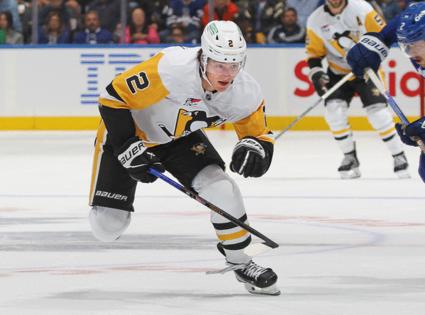Jason Mackey: Same as nearly a decade ago, Penguins could really use an infusion of youth
Published in Hockey
PITTSBURGH — Rutger McGroarty and Ville Koivunen sat side-by-side in the deepest part of the horseshoe-shaped Penguins locker room at UPMC Lemieux Sports Complex earlier this week, laughing and soaking up the scene.
Equipment bags for an upcoming road trip sat at their feet. On one side was a familiar face in Joona Koppanen. On the other, an NHL legend — someone with more point-per-game seasons than anyone ever — though Sidney Crosby, of course, was the last player off the ice.
It's prime real estate for these two youngsters.
And necessary when you consider the possibility — real, in my opinion — of the Penguins turning this around as soon as 2025-26.
For that to happen, McGroarty, Koivunen and others must play sizable roles, the same as Bryan Rust, Jake Guentzel, Matt Murray, Brian Dumoulin, Conor Sheary and others did nearly 10 years ago now, helping those Stanley Cup-hoisting Penguins elevate their game.
"I remember those days," McGroarty surprised me by saying after Wednesday's practice. "I watched those teams. The Penguins were dynamic in every aspect. It was a lot of fun. It would be really cool to be a part of something like that."
I doubt the confident and likable McGroarty — whose first NHL goal Thursday helped the Penguins pick up a point against the Blues — is the only one who feels that way.
Thursday marked just the fifth NHL game McGroarty (who just turned 21 on March 30) has played after a cameo to start the season.
It was just the second for Koivunen, a sheepish-but-skilled Finn who has had a breakout rookie season with Wilkes-Barre/Scranton. Among the numbers:
— At the time of his promotion, Koivunen (who will turn 22 in June) led Wilkes-Barre/Scranton with 55 points in 62 games.
— His 21 goals were the most for a WBS rookie since Daniel Sprong seven years ago.
— Only six skaters throughout the AHL had more points than Koivunen, who's just 5-foot-11, 161 pounds but tends to make plays with his skating, vision and smarts in a different way than the sizable and physical McGroarty (6-0, 200).
The common thread, of course, is that these guys — at least to this point — feel like more than hope-and-pray solutions. There's pedigree and production. Ditto for how they've developed and the games they employ.
Need evidence?
Mike Sullivan's usage of them should tell us plenty, though I also think there's an inaccurate label that the Penguins coach is unwilling to trust younger players.
No, he's unwilling to trust incomplete or inconsistent players. If a young guy shows he can do more, Sullivan will happily adjust. He's way too competitive to be stubborn. The problem is that not enough have shown true NHL readiness.
Think about this: Was Sprong a case of Sullivan being hard-headed, or simply an accurate evaluation? Probably the latter.
Nothing against Sprong, whom I actually really enjoyed covering, but he debuted nine years ago, has one 20-goal season on his resume and this year has played for four teams — three in the NHL and one in the AHL.
Zach Aston-Reese got chances. So did Valtteri Puustinen. Sam Poulin even had a few. We could go on.
Bottom line, Sullivan will allocate premium minutes to players he think can help, so I found it interesting that he started McGroarty and Koivunen in the Penguins' top-six this past week.
McGroarty skated with Crosby and Rust. Rickard Rakell had taken Evgeni Malkin's spot as the Penguins' second-line center, and Koivunen was on his right wing.
"I'm feeling more comfortable," Koivunen told me. "They gave me a chance right away in the top-six, so I've been enjoying every minute of that."
After practice Wednesday, I asked Sullivan to expound a little on how the Penguins arrived at this point of putting McGroarty and Koivunen in such sizable roles from the jump.
"It's a good question," Sullivan said. "The answer is that we're trying to put players in positions where they can play to their strengths and they can succeed."
That involves a couple things, Sullivan continued:
— They have to be capable of handling bigger assignments.
— Their hockey IQ has to match that of vets such as Crosby, Rust and Rakell.
— They must do things that add positive, discernible ingredients to their line while also inspiring confidence that they won't crumble at the first sign of trouble.
"As a coaching staff, we didn't believe they were in over their heads," Sullivan said. "We're certainly going to watch and see, then go from there. We do that with a lot of young guys.
"Having said that, performance matters. They will show through their performance where they fit. ... We think they possess the qualities that allow them to play in those roles. That's why we put them there."
That's the hockey side.
There's also a human element to this.
For that, I ventured over to Rust's stall and joked that I wanted to ask him a couple questions to make him feel old. We both laughed. Crazy that he debuted 11 years ago. But they're similar situations.
Rust scored some in the minors but was more of a bottom-six, worker type than anything. A case of the mumps jumped him into the top-six, and Rust had to adjust.
He learned a ton about playing with skilled guys, as well as being confident enough in his own game to score. Few have grown at the NHL level as much as Rust.
There's undoubtedly something for McGroarty to learn there about balancing skill with a blue-collar mentality, and some of that evolution happened with the former Winnipeg Jet producing a team-high 18 points since Feb. 15 prior to his recall.
In Pittsburgh, no surprise, McGroarty has been asking plenty of questions of Rust and Crosby.
"They've been phenomenal," McGroarty said. "Two great guys, class acts and great hockey players."
The Penguins obviously need more like McGroarty and Koivunen.
The same as how much it mattered back then, a competitive advantage in a capped league will always be young guys out-performing their contracts.
That's why it's on the Penguins to keep these guys on the same development tracks, for them to grow their games and do the work, and for current players to welcome them into the dressing room the way that it happened nearly a decade ago now.
To this point, the sample size is laughably small. But the blueprint and need should be coming into focus.
"I think it gives a little bit more energy to everybody else," Rust said of the kids playing bigger roles. "You see how excited they are to come to the rink every day, ready to go and soaking in every minute.
"That takes all of us back, and I think it lifts up everybody's game a little bit."
The Penguins can only hope.
____
© 2025 the Pittsburgh Post-Gazette. Visit www.post-gazette.com. Distributed by Tribune Content Agency, LLC.







Comments